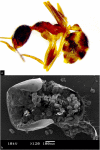Among the shapeshifters: parasite-induced morphologies in ants (Hymenoptera, Formicidae) and their relevance within the EcoEvoDevo framework
- PMID: 33653386
- PMCID: PMC7923345
- DOI: 10.1186/s13227-021-00173-2
Among the shapeshifters: parasite-induced morphologies in ants (Hymenoptera, Formicidae) and their relevance within the EcoEvoDevo framework
Abstract
As social insects, ants represent extremely interaction-rich biological systems shaped by tightly integrated social structures and constant mutual exchange with a multitude of internal and external environmental factors. Due to this high level of ecological interconnection, ant colonies can harbour a diverse array of parasites and pathogens, many of which are known to interfere with the delicate processes of ontogeny and caste differentiation and induce phenotypic changes in their hosts. Despite their often striking nature, parasite-induced changes to host development and morphology have hitherto been largely overlooked in the context of ecological evolutionary developmental biology (EcoEvoDevo). Parasitogenic morphologies in ants can, however, serve as "natural experiments" that may shed light on mechanisms and pathways relevant to host development, plasticity or robustness under environmental perturbations, colony-level effects and caste evolution. By assessing case studies of parasites causing morphological changes in their ant hosts, from the eighteenth century to current research, this review article presents a first overview of relevant host and parasite taxa. Hypotheses about the underlying developmental and evolutionary mechanisms, and open questions for further research are discussed. This will contribute towards highlighting the importance of parasites of social insects for both biological theory and empirical research and facilitate future interdisciplinary work at the interface of myrmecology, parasitology, and the EcoEvoDevo framework.
Keywords: Cestoda; EvoDevo; Mattesia; Morphology; Myrmicinosporidium; Nematoda; Parasitology; Review; Social insects.
Conflict of interest statement
The author declares that she has no competing interest.
Figures








References
-
- Abouheif E, Favé MJ, Ibarrarán-Viniegra AS, Lesoway MP, Rafiqi AM, Rajakumar R. Eco-Evo-Devo: the time has come. In: Landry C, Aubin-Horth N, editors. Ecological genomics. Advances in experimental medicine and biology. Springer: Dordrecht; 2014. pp. 107–125. - PubMed
-
- Blute M. Is it time for an updated ‘eco-evo-devo’ definition of evolution by natural selection? SponGe. 2008;2:1. doi: 10.4245/sponge.v2i1.4896. - DOI
-
- Gilbert SF. Ecological Developmental Biology. Hoboken: Wiley; 2017. pp. 1–8.
Publication types
LinkOut - more resources
Full Text Sources
Other Literature Sources
Research Materials

